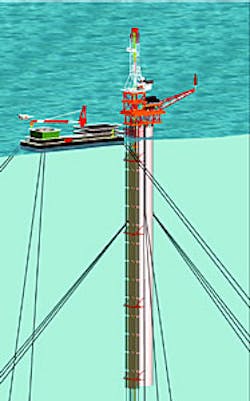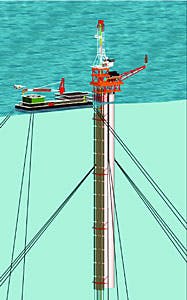Monocolumn Wellhead Platform Designed For Satellite Production In Deep Water
Stephane Anres, Olivier Lenormand
Bouygues Offshore SA
Paris
Monocolumn wellhead platform.Bouygues Offshore, in association with TPG (Technip Geoproduction) and IFP (Institut Fran?ais du P?trole), used the deepwater environment off West Africa to develop the monocolumn wellhead platform (MWP) for use as a satellite production system.
Designed for use with a more important production unit, such as a floating production vessel or floating production, storage, and offloading system, the MWP can be an alternative to the mini-TLP (tension leg platform) concept, existing deep-draft caisson vessel, or small clusters of subsea wellheads. The monocolumn is similar in principle to the existing deep-draft floater concepts already in operation in the Gulf of Mexico. The main differences are the location of the production risers outside of the column instead of inside a central moonpool and the material used to build the hull-concrete ins
tead of steel. This concept can suit 6-12 production risers. Drilling and workover operations would be performed in a tender-assisted mode.
The concept applies to water depths ranging from 500 m to 2,000 m. The base study took into consideration a water depth of 1,400 m in the Gulf of Guinea. Bouygues Offshore is developing the concept for harsher conditions offshore Brazil, in the Gulf of Mexico, and in the West of Shetland area.
The monocolumn consists of a deep draft concrete column with a steel truss type deck supporting minimal equipment for production (for instance first stage separation) and export of the product to the central production platform.
The very low dynamic motion allows surface wellheads with vertical rigid production risers. The platform would be unmanned under normal operation.
The risers to satellite subsea wells and liaisons with the host platform would be based on catenary rigid pipes and routed on the opposite side of the production risers.
Bouygues Offshore is leading the development of the MWP and is in charge of the overall concept design (including hull, mooring, and installation), with the assistance of TPG for the topsides design and its mating to the column, and IFP for the riser design using the Deeplines software.
Hull design
The column is made of prestressed high-performance concrete. It is constructed horizontally in a dry dock or a graving dock with overall dimensions of 280 m by 35 m and an available draft of approximately 8 m. The concreting cycle progresses from one end of the column towards the other end. Concrete segments are 5 m long cylindrical pieces cast in place.The column is divided into compartments by watertight transversal bulkheads in order to ensure stability during the towing and to allow the uprighting by water ballast transfer. The large stability is ensured by both heavy ballast (iron ore installed prior to towing out) at the bottom of the column and water ballast in the lower compartments. The upper compartment is equipped with an inner steel compartment forming a double hull ensuring stability and buoyancy of the column in case of accidental flooding.
Drilling, mooring
Drilling and workover are performed in tender mode.The tender barge provides:
- Accommodations for all personnel.
- All drilling facilities except hoisting (derrick set).
- Transport of the entire drilling package.
- Storage for tubulars.
The monocolumn and the tender are held in place with independent spread mooring systems as well as interconnecting lines.
The fairleads of the monocolumn are located approximately 50 m below the surface. This reduces the pitch angle of the column and facilitates the mooring of the drilling tender (by reducing the risk of interference between the different mooring lines). The mooring pattern of the monocolumn is composed of nine lines arranged in three groups 120? apart from each other.
Risers
The motions of the monocolumn are low enough to allow the use of rigid risers and to support surface trees. Extensive riser analysis for the Gulf of Guinea environment has been performed to prove the soundness of the riser arrangement.
The riser is connected to the column through a set of guiding systems distributed all along the column to avoid any risk of collision between the risers and the hull. In the case of eight production riser configuration, they are arranged in two rows of four risers.
Tensioning of the risers is provided by strings of buoyancy cans located at the upper part of the risers. The advantages of using buoyancy units rather than an active system are multiple:
- Absence of vertical and variable loads at the top of the support.
- No additional vertical stiffness.
- Better access to wellhead.
- Reduced maintenance.
Thanks to its deep draft (over 200 m) and its large inertia, the column has very low dynamic motions. The natural heave period is around 30 sec, well above the wave period range (5-25 sec).
Tank testing
Tank tests have been performed on a 1/60 scale model of the monocolumn at the Brest facilities of Ifremer (Institut Fran?ais de Recherche pour l'Exploitation de la Mer). Tests were performed with regular and irregular waves and aimed at determining the damping factors as well as validating a computer program developed for the hydrodynamic analysis. The column motion response was validated, and the very good behavior of the monocolumn due to its deep draft and its large inertia was confirmed.Installation
The column is towed horizontally in one element from the construction site and uprighted on site by transfer of water ballast between the compartments. The column is designed to withstand significant waves up to 7 m during the towing. Once on site in vertical position, the column is ballasted by flooding its lower part in order to get a sufficient stability.The column is then connected to the prelaid mooring lines, and the deck is installed on the column by a derrick barge.
The concrete hull constructed in one piece is able to withstand the towing conditions and allows local construction, which leads to a cost-effective minimal platform for deepwater developments.
The proposed riser arrangement outside of the hull allows a reduction in the column diameter compared with other conventional deep-draft caisson vessels which contributes to a very simple design, construction, and installation of the monocolumn.
The concept would be of particular interest for fields requiring a development using several dispersed drilling centers or for the development of marginal fields located near existing production facilities.
The Authors
Stephane Anres is a section leader in the R&D Division of Bouygues Offshore SA and project manager for the development of several deepwater concepts including barge type and deep draft floaters. He joined Bouygues in 1990. He received an engineering degree from the Engineering School of Marseilles and an MSc in mechanical engineering from Carnegie Mellon University.
Olivier Lenormand is an R&D project engineer in charge of the development of the monocolumn concept. He earned an engineering degree from the Engineering School of Marseilles in 1995 and an MSc in Physical Oceanography from University of Marseilles.
Copyright 1999 Oil & Gas Journal. All Rights Reserved.

